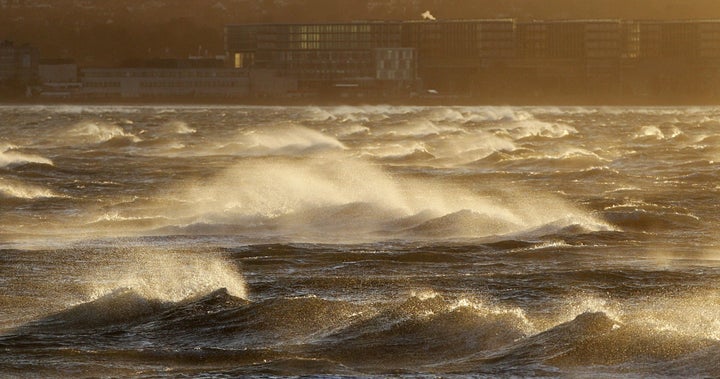
Recently my Chesapeake Bay retriever and I had the rare privilege of getting very close to the largest animal on Earth -- a majestic blue whale. It was humbling and a good reminder that humans are but one strand within the rich web of life on our planet.
As we continue to recklessly spew more than 82 million metric tons of greenhouse gases into the biosphere, daily, consider what's occurring around us and that change is imminent as nature has only just begun to flex her wild power.
The other day the UK was lambasted by gale force winds and anyone who happened to see the pictures was left speechless. For instance, in the valley of High Cup Nick, Cumbria, it was so windy that a waterfall ran uphill.
While most of Australia is sweltering in a prolonged heat wave the Brindabella Range behind the capital city, Canberra is freezing. Its mountaintops and snow gum forests are blanketed in snow, at the height of their summer.
Polar bears, apex predators, near Churchill, Manitoba, Canada are starving and forced to feed at an old garbage dump. There was no polar ice in November hence they couldn't hunt nor feed on seals. Missing November ice is becoming the new normal and these critters are doomed.
Currently, it's so warm in Alberta, Canada that the government is asking the people to treat January as if it were June as the entire province is tinder-dry and highly flammable. In the first week of January raging grass fires have already scorched over 6,600 acres.
Northern Alberta is home to the second largest hydrocarbon reserve on the globe locked in oil sands, when burned we will knowingly have raised atmospheric CO2 levels by 150 ppm. Earth will be uninhabitable for life as we know it.
Further north there's exceptionally little ice in both the Barents and Kara Seas. In parts of the Barents Region temperatures in the autumn were 13 degrees Fahrenheit warmer than normal, those temperatures extended throughout large areas of northern Europe.
Satellite images unmistakably show that the Arctic is missing vast amounts of sea ice in January north of Spitzberg and north of Novaya Zemlya as sea temperatures are unseasonably warm.
Parts of Alaska, on the other hand, are attempting to contend with 18 feet of snow. As of January 10, 2012 only 14.7 percent of the U.S. was covered by snow compared to 61.7 percent at the same time last year.
Lack of snowfall has some very serious consequences for 55 million of us who live in the West. Currently, California is on track for what could be the driest year on record. Not only is snowfall and the accumulated snowpack in the Sierra Nevada's significantly below normal, so too are conditions in Colorado's Rockies and Utah's Wasatch Range. Springtime melt-waters from snowpacks are imperative for agricultural irrigation and drinking water in the following cities: Las Vegas, Phoenix, Tucson, San Francisco, San Diego and Los Angeles. In addition, melt-waters from the Sierra's sustain the eighth mightiest economy on the globe: California.
Intense forest fires are burning in the drought-plagued Patagonia rainforests of Chile and Argentina where naturally occurring fires are very rare. These burnt mountain rainforests will take at least decades but more likely centuries to recover.
Elsewhere across Middle and South America intense flooding and droughts have annihilated large regions of Columbia, Chile and Argentina. Mexico is in the grips of the worst drought since the inception of continuous record keeping in 1942. This drought is impinging upon our food security as the U.S. relies upon Mexico to supply millions of pounds of fresh fruit and vegetables, daily -- especially in the wintertime.
Parts of Nebraska are 30 degrees Fahrenheit warmer than normal. The vicious drought enveloping Texas has entered its second year, in excess of $7 billion of agriculture damage has occurred and likely this drought will wipeout the last surviving whooping cranes along the Gulf Coast. These beauty of beasts, North America's tallest birds, require high protein diets from berries and blue crabs in marshes, which have dried-up, to sustain them throughout the winter. In the springtime these remarkable birds (about 300 left) must fly over 2,500 miles north, without stopping to eat, to mate and lay one egg.
A recent Duck's Unlimited study has linked millions of missing scaup and scoter ducks to a warming world where spring in the north country is occurring 11 days earlier. Low snow cover has failed to replenish the northern waterways; scaup and scoter duck populations have dramatically fallen by 40 and 60 percent respectively, in just three decades.
It's not just the animals that are struggling to survive in an over-heating world - plants are also very confused. Snowdrops -- early spring flowers -- have unfurled in the National Arboretum, Washington, D.C. And apricot trees in Atlanta, which normally bloom in April, are bearing flowers now.
The warm temperatures across the West will favor a trillion bark beetles this springtime as the fate of the thrifty high elevation limber and whitebark pines that cling along the entire Rocky Mountain chain seems very bleak - indeed. Already across the West, instead of sucking CO2 out of the air, billions of mature beetle-killed trees are decaying and bleeding more heat-trapping greenhouse gases into an ever-rising atmospheric pool.
How much more senseless damage to the web of life must we endure before assuming responsibility, taking action and lightening our global footprint?
The time to take care of our environment is now.
Australia has a low-carbon plan in place. China is proposing a low-carbon plan for 2015. Clearly, it's time for the U.S. to step-up-to-the-plate and unveil our version of a low-carbon, 21st century economy.
Earth Dr. Reese Halter is an award-wining science communicator: voice for ecology and distinguished conservation biologist at California Lutheran University. His latest books are The Insatiable Bark Beetle and The Incomparable Honeybee. Contact Earth Dr. Reese Halter
